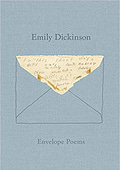There are those
who are shallow
intentionally
and only
profound
by
accident
p. 78
Emily Dickinson is the most famous female American poet. A prolific writer, but none knew of her work as only 10 poems of hers were published in her lifetime. How prolific was she? Between 1870 to 1885, she wrote over 1800 poems. It wasn’t until after her death her sister published her poems.
In a small bookstore in Glen Arbor, Michigan, I picked up a book of some of her compiled poems called, Envelope Poems.
Dickinson wrote so much she wrote on whatever piece of paper she could get a hold of. This collection of poems are fragments of paper upon which she scribbled her notes, anecdotes, and short poems. Most of the fragments were envelopes repurposed as her medium.
Envelope Poems presents photographs of the actual fragments on one side of the page, the words in type on the other in the same form and placement in the original. The type is helpful in reading her work as my 21st century eyes are hard to read her 19th century hand writing.
Look back
on Time
with kindly
Eyes -
He doubtless
did his best -
How softly
sinks that [his]
trembling Sun
In Human
Nature’s West -
p. 36
There are two things I have learned from this little book. First, to write often and anywhere. Dickinson wrote her notes and poems on whatever piece of paper she could find. Paper manufacturing during her time was on the rise, which afforded her access to paper few before her had. However, paper was not as prevalent as as it is now. Today, paper is everywhere. You can buy a little note book of 60 sheets for less than a dollar. With technology - phones and tablets - one can write and take notes with ease at anytime. There is no excuse not to write. Dickinson inspires me to write, and write some more.
One note from
One Bird
Is better tan
a million words
A Scabbard
Has - holds [needs]
but one
sword
p. 48
The second thing I learned is to write for yourself. Dickinson wrote over 1800 poems. Almost all of them weren’t published during her lifetime. It wasn’t because no one wanted to publish her work. She didn’t want her work published. She was writing for herself, her own amusement, her own therapy, her own well being; no audience, critiques, or admirers. The acclaim came after her death. Having had written was her own fulfilment.
Though I write here in the public eye, I am learning I am not writing for you (though I hope you enjoy it and are helped by it). I am writing for my own sense of purpose and fulfillment.
One day, I will write more of Emily Dickinson’s poetry from her massive collection. But now, I will leave you with one from this little book, Envelope Poems - it speaks about her life, and perhaps an unrecognized prophecy.
All men for Honor
hardest work
But are not known
to earn -
Paid after they have
ceased to work
In Infamy or Urn
p. 14



